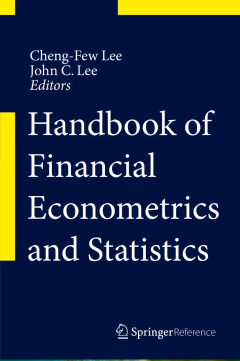Filter by

The Influence of Blockholders on Agency Costs and Firm Value
Markus P. Urban investigates the influence of large shareholders (the so-called blockholders) on agency costs and firm value, thereby accounting for blockholder characteristics and blockholder interrelationships. The work provides a profound theoretical and empirical analysis on the nature and effect of shareholder engagement with due regard to the specifics of the German institutional environm…
- Edition
- -
- ISBN/ISSN
- 978-3-658-11402-2
- Collation
- XXXVI, 462
- Series Title
- Auditing and Accounting Studies
- Call Number
- -

The Icelandic Financial Crisis
This book presents a detailed account of Iceland’s recovery from the tumultuous banking collapse that overturned its financial industry in 2008. Early chapters recount how Iceland’s central bank was unable to follow the quantitative easing policies of the time to print money and save the banks, while serving the world´s smallest currency area. The book goes on to explore how the government…
- Edition
- -
- ISBN/ISSN
- 978-1-137-39455-2
- Collation
- XVI, 349
- Series Title
- Palgrave Macmillan Studies in Banking and Financial Institutions
- Call Number
- -

The Handbook of Post Crisis Financial Modelling
This unique Handbook brings together leading practitioners and academics in the areas of banking, mathematics, and law to present original research on the key issues affecting financial modelling since the 2008 financial crisis. As well as exploring themes of distributional assumptions and efficiency the Handbook also explores how financial modelling can possibly be re-interpreted in light of t…
- Edition
- -
- ISBN/ISSN
- 978-1-137-49449-8
- Collation
- XIX, 316
- Series Title
- -
- Call Number
- -

The Global Financial Crisis and the Indian Economy
After tracing the causes of the global financial crisis, the book focuses on two fundamental systemic issues connected with its manifestation: financial-sector regulation and the problem of the dollar-centric international monetary system, both of which have been widely cited among the important factors leading to the 2008 financial crisis. The important analytical question of monetary policy t…
- Edition
- -
- ISBN/ISSN
- 978-81-322-2395-5
- Collation
- XI, 142
- Series Title
- -
- Call Number
- -

Water, Politics and Money A Reality Check on Privatization
This book reveals all that can potentially happen when a private company takes over a local water supply system, both the good and the bad. Backed by real life stories of water privatization in action, author Manuel Schiffler presents a nuanced picture free of spin or fear mongering. Inside, readers will find a detailed analysis of the multiple forms of water privatization, from the outright…
- Edition
- -
- ISBN/ISSN
- 978-3-319-16691-9
- Collation
- XIX, 214
- Series Title
- -
- Call Number
- -

Venture Capital and the Inventive Process VC Funds for Ideas-Led Growth
The inventive process is the most important driver of economic growth. Venture capital (VC) funds have contributed a small, but critical, part to the inventive process. VC funds boost the inventive process by selecting a small number of radical ideas out a large flow of ideas and invest in their testing, development and commercialization. They bring together capital from general savings, manage…
- Edition
- -
- ISBN/ISSN
- 978-1-137-53660-0
- Collation
- XIV, 123
- Series Title
- -
- Call Number
- -

Valuing the Innovation Potentials of Firms What Theory Suggests, Practitione…
Jan Buchmann focuses on the valuation of a firm’s innovation potential based on that firm’s position in its lifecycle. Compared to existing research, the author does not center his research exclusively on mathematical valuation methodologies. Instead, the author compares collected valuation input data, data interpretation approaches, and valuation methodologies suggested by theory with the …
- Edition
- -
- ISBN/ISSN
- 978-3-658-09290-0
- Collation
- 9 b/w illustrations
- Series Title
- -
- Call Number
- -

Valuing Banks A New Corporate Finance Approach
This book aims to overcome the limitations the variations in bank-specifics impose by providing a bank-specific valuation theoretical framework and a new asset-side model. The book includes also a constructive comparison of equity and asset side methods. The authors present a novel framework entitled, the “Asset Mark-down Model”. This method incorporates an Adjusted Present Value model, whi…
- Edition
- -
- ISBN/ISSN
- 978-1-137-56142-8
- Collation
- 19 b/w illustrations
- Series Title
- -
- Call Number
- -

Value Economics The Ethical Implications of Value for New Economic Thinking
The last financial crisis revealed a gap between business practice and ethics. In Value Economics, Griffiths and Lucas examine some of the reasons for this ethical gap and discuss the resulting loss of confidence in the financial system. One of the reasons has been hazy or inadequate thinking about how we value economic enterprises. With the close link between the creation of value and business…
- Edition
- -
- ISBN/ISSN
- 978-1-137-54187-1
- Collation
- XV, 281
- Series Title
- -
- Call Number
- -

Handbook of Financial Econometrics and Statistics
The Handbook of Financial Econometrics and Statistics provides, in four volumes and over 100 chapters, a comprehensive overview of the primary methodologies in econometrics and statistics as applied to financial research. Including overviews of key concepts by the editors and in-depth contributions from leading scholars around the world, the Handbook is the definitive resource for both class…
- Edition
- -
- ISBN/ISSN
- 978-1-4614-7749-5
- Collation
- CXII, 2897
- Series Title
- -
- Call Number
- 330 HAN
 Computer Science, Information & General Works
Computer Science, Information & General Works  Philosophy & Psychology
Philosophy & Psychology  Religion
Religion  Social Sciences
Social Sciences  Language
Language  Pure Science
Pure Science  Applied Sciences
Applied Sciences  Art & Recreation
Art & Recreation  Literature
Literature  History & Geography
History & Geography